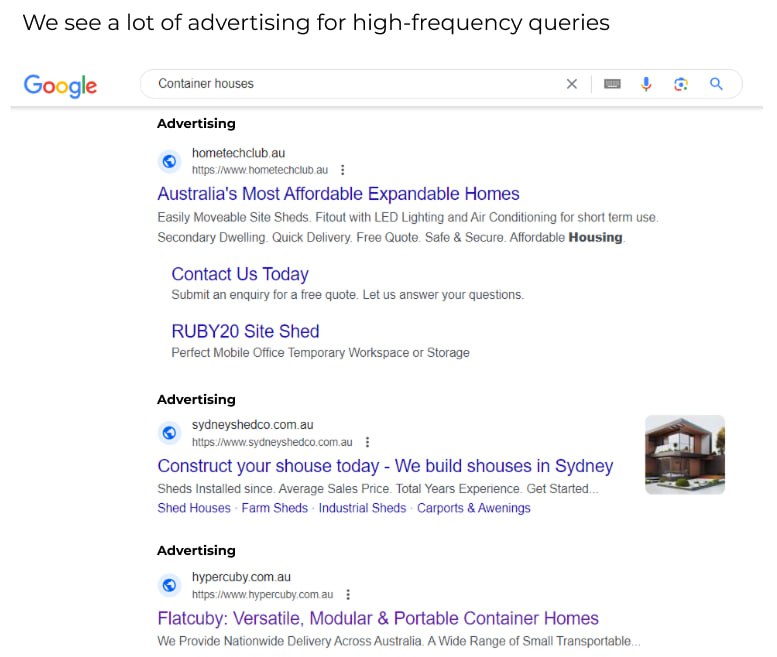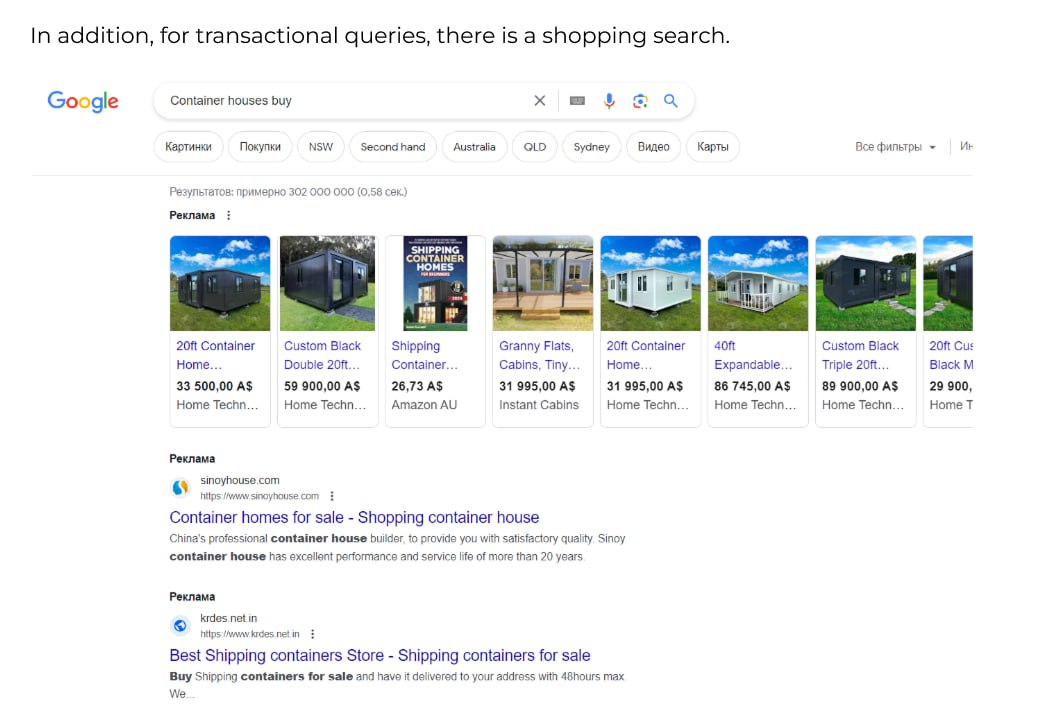The real estate market in Australia is a dynamic area where rapidly rising residential and commercial property prices are creating opportunities for alternative solutions that differ from conventional construction.
Imagine that instead of a long and expensive construction process, you can have a house delivered and assembled quickly. The idea is quite attractive, but there are many questions about the demand and competition in this niche.
Our client is a company with experience in the field of interior furnishing solutions that has decided to expand its business and explore the prospects of entering the container house market in Australia.
How can a new brand not only enter this market, but also become the choice of customers?
“We have a vision, but we are not sure how to implement it in a new market for us”, the company’s founder shared with us during our first meeting. In his eyes, we could see a mixture of enthusiasm and restraint — typical of an experienced entrepreneur facing a new challenge.
Our client had expertise in his field, but he needed a strategic plan to successfully launch a new business. And the questions he was concerned about were quite clear:
- Is there potential for a container house business in Australia?
- What is the most effective business model?
- Which marketing tools will give you the best results?
Our task is to create a marketing strategy that:
- Assess the potential demand and business prospects in Australia.
- Determine the best business model for a quick start.
- Develop a comprehensive marketing plan for entering the market.
| How long did it take to develop the strategy? | 150 hours, 6 working weeks |
| What is the composition of the marketing strategy development team? | Head of Marketing Team, Head of Content Team, project manager, operational marketer, SMM marketer, Head of PPC Department, PPC Facebook specialist. |
| How were the results of the work used? | Independent implementation by the client’s specialists. |
Project subject
When we first met with the client’s team, we conducted a briefing and interview, which is an integral part of our work. This helped us to synchronise with the client’s vision, values and ambitions.
💡 Container houses are an innovative solution for housing and commercial premises created from converted freight containers. Converted containers provide an affordable, environmentally friendly and fast solution for a variety of needs from housing to offices.
Like a house that only needs to be installed and is immediately ready to serve as a home or workplace. There is no lengthy construction, no extra costs or waiting around for — you just get a modern, functional and stylish space in no time:
Photo of a container house
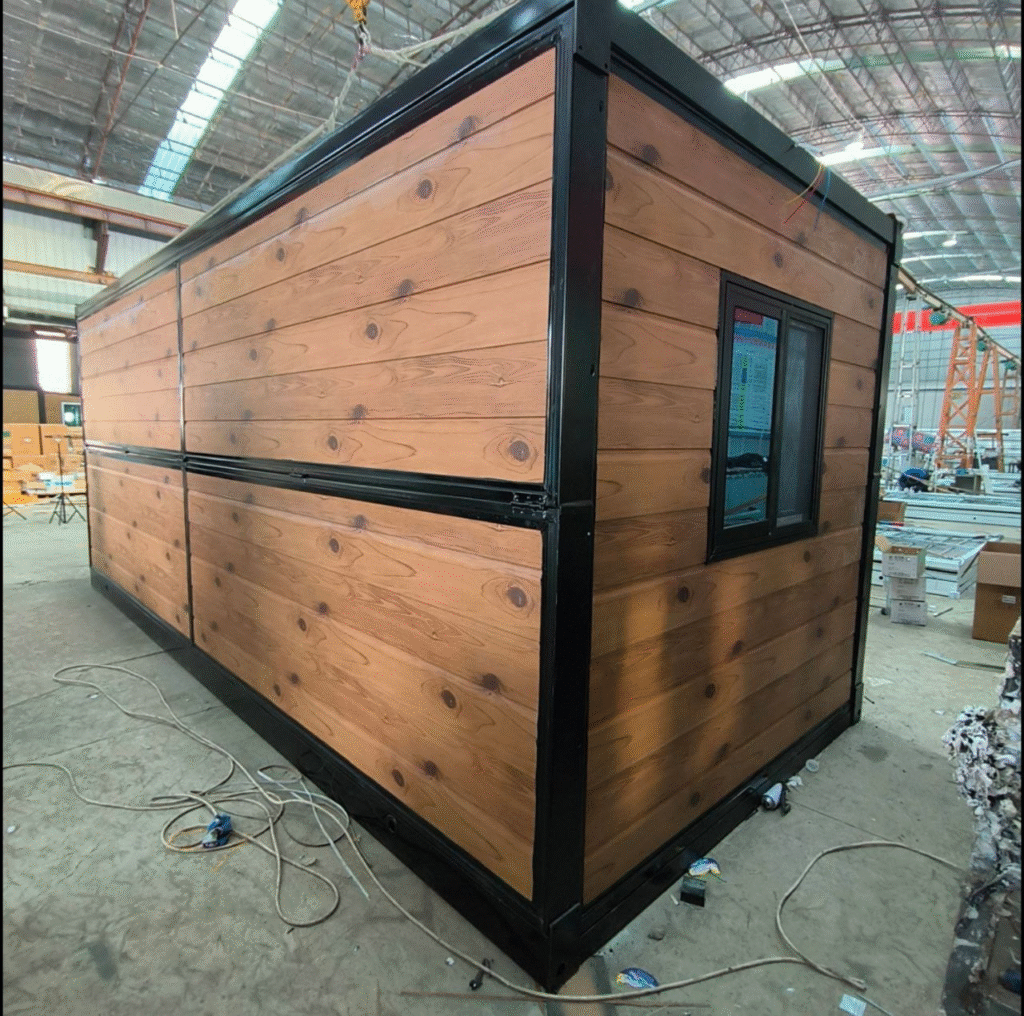
The main challenge was to identify the prospects for this business in the Australian market and develop an effective exit strategy in the face of competition from local companies that had already taken their positions.
Goals and our first steps
Our mission was clear: to help the client make an informed decision about launching a new business and provide a strategic action plan for a successful start.
But to do this, we first needed to answer a few key questions:
- What is the real demand for container houses in Australia?
- Who are the main competitors and what are their weaknesses?
- What is the best business model for rapid market entry?
The answers to these questions became the starting point for developing our marketing strategy.
How we researched the market and audience
To develop an effective marketing strategy for the client, our approach consisted of several key stages:
Market trend research
“Numbers don’t lie” is always at the heart of our research.
We have studied the general trends in the container housing sector using a variety of industry research data, Google Trends analytics and consumer preference reports. This helped us understand that the market is growing at a rapid pace and the demand for affordable housing is becoming increasingly relevant.
Our analysis included:
- Studying the dynamics of keyword searches.
- Analysis of the seasonality of demand for container houses.
- Tracking the growth of interest in different product categories.
What did we find?
The container house market in Australia is showing steady growth. The global container house market is expected to grow to USD 84.38 billion by 2028, at a CAGR of 5.9%.
Key growth drivers:
- housing affordability issues;
- design flexibility;
- raising environmental awareness;
- urban reconstruction projects;
- state support in certain regions.
Study of competitors and audience demand
Next, we analysed the main market players, which included:
- A detailed study of their websites and usability.
- Analysis of their product range and pricing policy.
- Research their marketing activities and communication channels.
- Evaluation of positioning strategies.
📊Key conclusions of the competitor analysis:
- The average cost of a container house from competitors is $16,000-20,000.
- Our client can offer similar quality for $10,000-15,000.
- The ability to personalise is a weakness of competitors, which can be used as a USP.
- Most competitors focus on the Australian origin of the company, which creates a sense of understanding of local needs.
Insight: Most of the competitors had a clear specialisation (modular structures, extension houses, prefabricated buildings), but no one offered a personalised approach with flexible design settings.
This was a key argument on which the brand could build its uniqueness.
Creating a portrait of the target audience
Based on the analysis of customers, competing brands and sociological data, we created extended portraits of potential buyers:
- Young families (25-40 years old) looking for affordable housing.
- Landowners who need a quick solution.
- Small businesses looking for a low-cost solution for an office or retail outlet.
- Remote workers who need a home office.
💡Container houses are mostly perceived by customers as a ready-made product from a catalogue, so if you rely on personalisation, you need to interest the customer and show the specific benefits of this personalisation.
Choice factors are a unique methodology and the key to understanding customer decisions
Working with the choice factors framework makes it possible to clearly understand what exactly influences a customer’s decision: why they choose a particular product, what arguments they trust, what motivates them to make a purchase or come back again. This is not an analysis of individual characteristics, but a comprehensive approach to strategic business development.
How it works:
- We research all possible choice factors — from the first encounter with a product to the moment of repeat purchase.
- We determine which of them are critical for potential customers in a particular niche.
- We show how these factors can be used in marketing, product and service to maximise growth.
Based on our research, we have identified and categorised 120+ choice factors that influence buyers’ decisions in the container house niche:
Choice factors
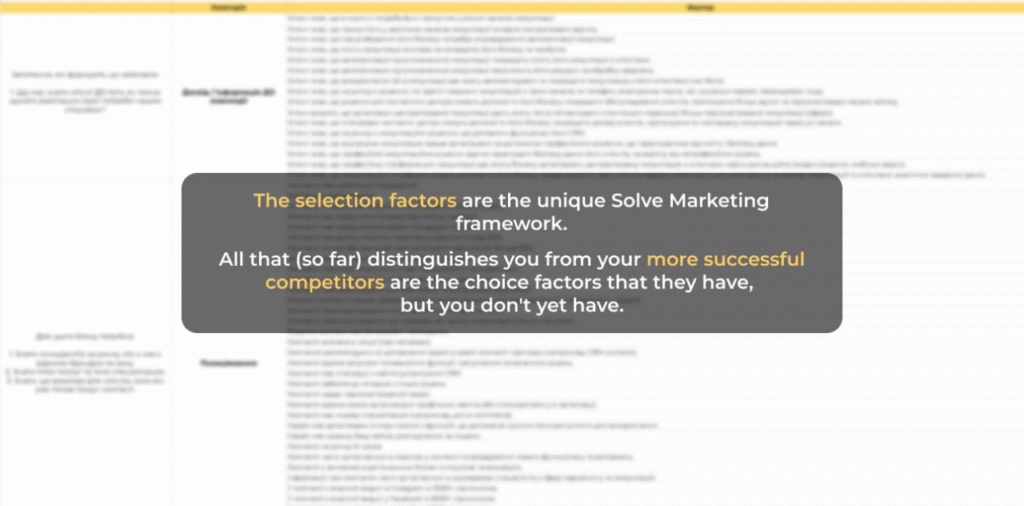
This approach provides businesses with a clear system that allows them to influence customer choice, create demand, and scale effectively. Read more about the choice factors framework here.
Are you planning to enter a new market?
Let’s create a step-by-step development plan together!
How we built the strategy: from idea to implementation
For us, developing a marketing strategy is a process where each stage helps to create a holistic picture, form expert opinions and hypotheses for testing that will ensure long-term results.
After analysing the market and competitors, we went deeper into the following stages:
Stage 1: Defining the business model
The challenge we identified: the client faced the choice of the optimal business model — to focus on the B2C segment or work with B2B clients (construction companies, developers).
Based on our research, we have proposed two key models:
- Direct sales of container houses through the website and online advertising.
- B2B model (supply to construction companies and developers).
Our recommendations:
- Start with a combined model that covers both B2C and B2B areas.
- At the initial stage, focus on the B2C segment for a faster return on investment.
- Gradually develop the B2B channel by establishing partnerships with construction companies.
Stage 2. Optimisation of the website and communications
The challenge we identified: at the time of launch, the client did not have a separate website for container houses, which complicated the pro
Our recommendations for creating a website:
Site structure
Key elements
| Home page | — Clear positioning — Key benefits — Examples of completed projects |
| Product catalogue | — Detailed photos — Technical specifications — Personalisation options |
| Page “Why Container Houses?” | — Educational content — Comparison with traditional construction — Environmental benefits |
| Application form | — Simple and clear conversion form — Clear CTA: “Get a personal consultation on the selection of a container house” |
💡Insight: the site should not just be beautiful or load quickly. Its purpose is to provide answers to the client’s questions: about the options for houses and their decoration, delivery and payment methods. Answer questions about how to live and work in such a house. Show real people who have chosen such housing and tell their stories.
Stage 3. Content strategy and social media
The challenge we identified: the audience knew little about the benefits of container houses, and traditional advertising tools were not trusted. It was necessary to create a strong information foundation for promotion.
Our recommendations:
Content strategy
Implementation will include
| Blogging | — articles on related topics (how to decorate a house, design trends, etc.); — PR articles about certain types of houses (a new product in the company and a detailed story about it, a story about the advantages of a container solution compared to a conventional one, etc;) — case studies and/or interviews with owners: what was the task, how the problem was solved, how long it took, what was done, how much it cost, the client’s impression; — company news (participation in promotions, exhibitions, obtaining certificates, starting cooperation, etc;) — advice from experts and answers to potential customer questions. |
| Placement of PR materials | — Searching for platforms to place among partners (related areas, for example, plumbing, repairs, etc.) or major news platforms; — fixing the positioning and mention of a unique offer in the texts (affordable cost); demonstration of your own expertise and — introduction to the person representing your brand; —link to the website to increase traffic. |
| Development of email marketing | — company news (new service / new modification / certification, etc.) — new cases, interviews with clients (they can broadcast these materials to their clients to get an affiliate bonus from you for the referred client). |
Stage 4. Launch of advertising campaigns
We analysed the risks and feasibility of promoting the product in various systems, including Google, and saw:
Advertising in search
This makes it clear that advertising can bring effective results on different platforms on Google.
That’s why our recommendations included the launch of advertising campaigns on:
- Google Search.
- GDN (advertising in the contextual media network).
- Performance Max (product feed only).
- Dynamic remarketing (after accumulating audiences).
We described to the client a step-by-step plan for launching advertising campaigns — from the moment of account registration to scaling the results — and provided budget calculations in the form of a media plan (optimal and minimum):
Media plan
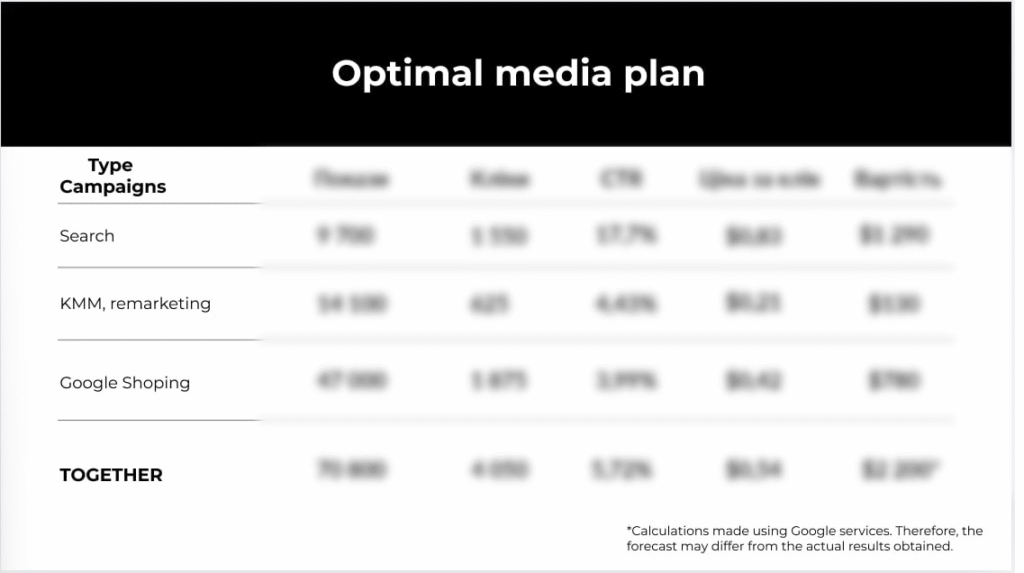
Conclusions
In 6 weeks of work, we:
- Have conducted a comprehensive analysis of the market and competitors, identifying prospects, opportunities and threats.
- Have determined the optimal business model with a combined B2C and B2B approach.
- Have developed detailed recommendations for website design and customer communication.
- Have developed a content strategy with a focus on educational content and social proof.
- Have prepared a plan for launching advertising campaigns with predictable performance indicators.
Although our client already had deep expertise in the field of home furnishings, launching a new business in the container house niche is a challenge and a market test. Even if you are a guru in your field, a new direction means different customers, competitive environment and market stereotypes.
Insight: For entrepreneurs who have been working in their niche for years, there seems to be nothing new that they don’t know about the product and customers. However, in the process of researching and drawing conclusions, many nuances turn from intuitive to conscious understanding. As a result, it is possible to work out the factors of customer choice in a high-quality manner and consciously understand what exactly to focus on.
That is why a marketing strategy is an essential tool that allows you to see the real picture of the market. As a result, a brand receives a personalised development and scaling plan based on a comprehensive approach — from analytics to choosing the most effective marketing tools.
Key findings from the project:
- For niche products, such as container houses, an integrated approach to marketing is most effective. It is impossible to achieve success using only one channel of promotion.
- A successful strategy is preceded by in-depth market and audience research. Even if a client has an understanding of their target audience, in-depth analysis always opens up new opportunities for targeting.
- In a new niche, a personalised development plan is a critical success factor. Developing a strategy that focuses on customisation and flexibility provides a long-term advantage over competitors.
A marketing strategy for innovative products needs to be flexible and adaptive to respond quickly to changes in consumer behaviour and market trends.
Are you developing your business in a new niche? We will find an effective strategy!
✔ Evaluate the market to determine the potential and growth points.
✔ Analyse your website to find ways to improve conversion.
✔ We will create a personalised development strategy adapted to your brand.
🚀 Ready to scale?
FAQ: frequently asked questions about the strategy of entering a new market
❓ How do I determine the prospects of a new business line?
✅ The key factor is to identify gaps in the market that your brand can fill with its unique offer.
❓ What is the optimal business model for starting a container house niche?
✅ At the initial stage, we recommend focusing on the B2C segment for a faster return on investment with the gradual development of partnerships with construction companies for the B2B channel.
❓ How long does it take for a new business to start making a profit?
✅ Stable profit begins after 6-12 months of consistent implementation of the marketing strategy. It is important to consider marketing as a long-term investment in the development of your brand.
